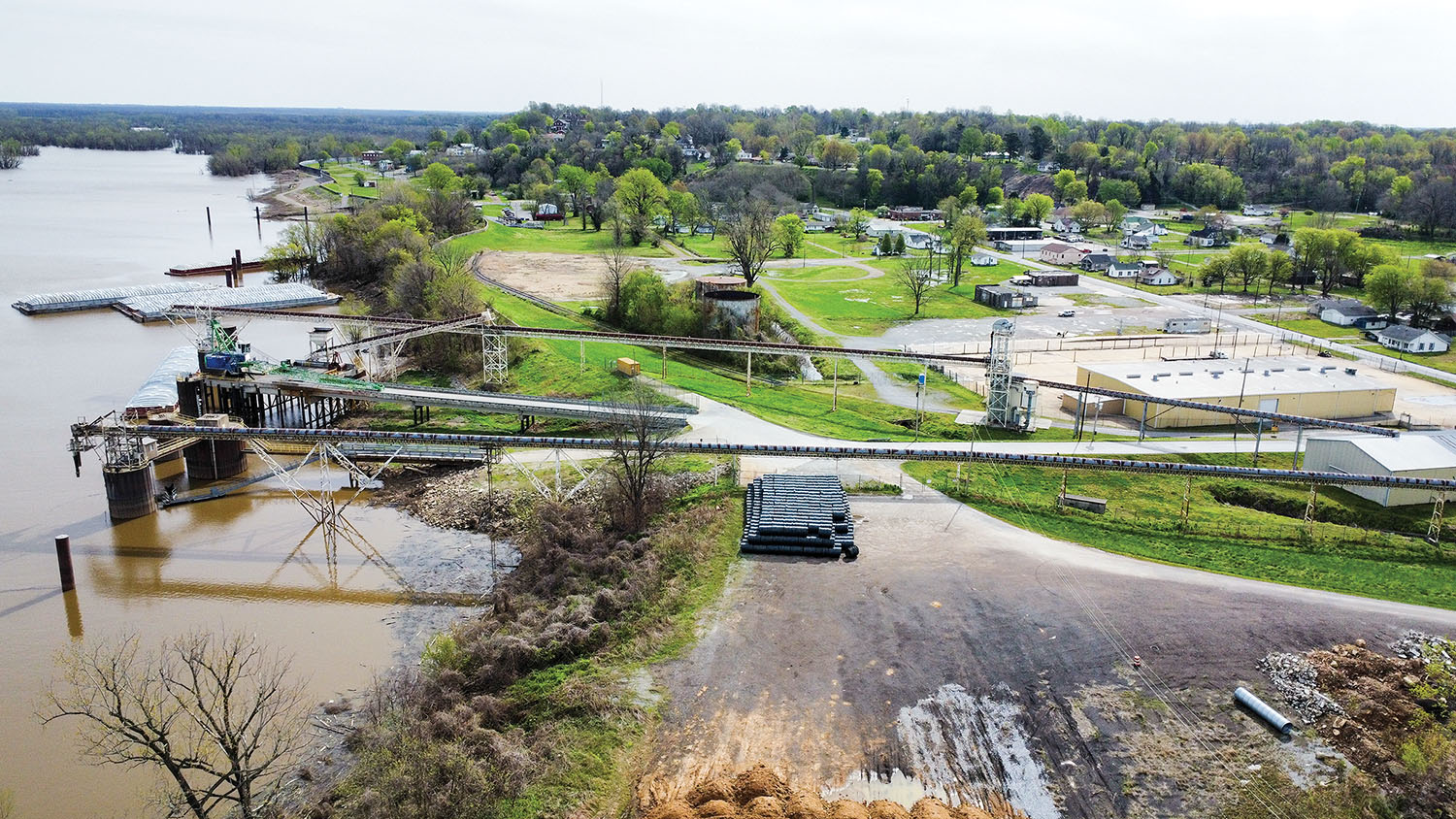A federal Port Infrastructure Development Program (PIDP) grant of nearly $3.3 million announced November 3 is not only replacing a conveyor system and mooring cell but also ensuring one western Kentucky riverport’s ability to continue operation for decades to come.
Greg Curlin, executive director of the Hickman-Fulton County Riverport Authority, said the port was within four or five years of having to close without the much-needed funding. Now, he said, he anticipates it will be able to operate for another 40 years.
The riverport, located at Lower Mississippi Mile 922, is Kentucky’s only public riverport on the Mississippi River. It became active in 1978, but it is using the grant to replace and upgrade a 1,200-foot conveyor system that dates to 1977.
“At that time, it was able to handle the amount of grain coming through the riverport, but it’s probably tripled since then,” Curlin said. “It’s not been able to keep up.”
The riverport handled 12 million bushels of grain last year, even though it was closed for eight days because of low-water conditions. It has handled up to 18 million in recent years, Curlin said. He added that with grain silos in nearby communities, including Mayfield, Ky., having been destroyed in December 2021 tornadoes, more grain is moving directly from fields to the river, so the port’s services are in high demand.
One of the two conveyors being replaced is for a grain-handling facility that Cargill Corporation is leasing at the port. The second belt loads out directly to barge or rail from truck, from a variety of customers. The systems will be upgraded from a 30-inch-wide belt system to a 48-inch system to meet rising demand and ensure reliability.
The grain conveyor upgrade will increase the amount of grain loaded per hour by 160 percent, according to the grant application. The current conveyor system handles 12,000 bushels of grain per hour. The new system is to be designed to increase the grain loading capacity to 20,000 bushels of grain per hour.
The grant also allows high-priority repairs to the attached 20-foot mooring cell that supports the conveyor system. Mooring Cell 6 is described in the grant application as suffering from “severe corrosion and settlement.” The PIDP grant also allows for construction of foundations for the conveyor, electrical infrastructure and control mechanisms. Additionally, the grant will include environmental, engineering, construction administration, testing and inspection and procurement services.
Curlin called the repairs and upgrades imperative. While previous surveys had suggested some issues with mooring cells, he said, low-water conditions showed that three of the port’s mooring cells are in worse condition than originally anticipated.
The conveyor was also showing signs of wear and was down for increasingly frequent repairs, Curlin said, adding that a reliable conveyor is vital to maintaining business with port tenants. The new system will also lead to greater efficiencies and energy savings, he said.
This will be the biggest rehabilitation in the port’s history, Curlin said, and is the first major work undertaken since the addition of a loading dock 25 years ago.
Mark Welch, president of Fulton-Hickman Counties Economic Development Partnership, talked about the importance of the riverport to the region, both in terms of economic impact and the potential to attract other investments.
“Particularly in rural areas, multi-modal assets are critical,” he said. “We talk all the time about the three R’s: the rivers, roads and rail, and we’re fortunate to have an important riverport in Fulton County. It’s obviously critical to the agriculture industry, which is a huge economic sector for us.”
He added, “If we were to lose that port, it would be devastating, particularly because of the importance of the grain that they transport. There are other commodities that go in and out of that port, but grain is huge.”
As a rural area, western Kentucky is dependent upon agriculture business and “ag tech” as a critical area for the growth of the economy, Welch said. As an example, he mentioned a Fulton County bourbon distillery that is growing rapidly, with company representatives trying to buy all the distillery’s grains locally.
Additionally, he said, the riverport is key to any potential business that may come from container-on-barge shipping in the future.
Welch noted that of all the applications for PIDP grants, the Hickman-Fulton County Riverport was the only Kentucky port project to be approved for a grant in the latest round of funding announcements.
“That says something about how the federal government sees the importance of that port,” he said.
The PIDP grant requires a 20 percent local match. Welch said the port is seeking a Kentucky Product Development Initiative Grant to cover about $450,000 of that funding and is also seeking a funding set aside as part of House Bill 9, which passed into law in Kentucky earlier this year and was specifically meant to provide local matching funds for federal grants awarded in Kentucky. Additionally, Curlin added that the port has been working closely with Fulton County authorities to secure any funding not covered via other means.
Caption for photo: The Hickman-Fulton County Riverport will receive $3,295,879 from a federal Port Infrastructure Development (PIDP) grant announced November 3. Port and economic development officials says the grant funds are key to continuing port operations well into the future. (Photo courtesy of the Hickman-Fulton County Riverport Authority)




